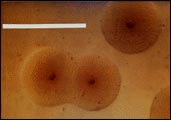
When you think of synthetic life, how many of you conjure up an image of Bishop 341-B, from the 1986 science fiction film Aliens or do you think of the largely genetic focused science instead?
Well, if neither of these ring a bell in your noggin', you should know a scientist by the name of Dr. Craig Venter.
Dr. Venter is renowned for his role in being one of the first to sequence the human genome and for his role in creating the first cell with a synthetic genome (2010). Also to his credit as a biologist and entrepreneur, he has founded Celera Genomics, The Institute for Genomic Research and the J. Craig Venter Institute.
The Craig Venter Institute (CVI) announced May 20th, 2010 the successful creation of "synthetic life". Published online as Gibson, D. G., et al. 2010, "Creation of a Bacterial Cell Controlled by a Chemically Synthesized Genome", in Science 2 July 2010: Vol. 329. no. 5987, pp. 52 - 56, DOI: 10.1126/science.1190719Science. The paper described the work undertaken to produce what has been called--Mycoplasma mycoides JCVI-syn1.0.
Essentially, a complete genome has been constructed from the four principal deoxyribonucleic acids that comprise a genetic map and this "man-made" genome was injected into a M. capricolum cell devoid of DNA. Mycoplasma mycoides JCVI-syn1.0 is reported to be self-replicating since initiation, a critical observation to ensure that this "man-made" form of life is stable.

M. mycoides and M. capricolum are bacterial species of the Mycoplasma mycoides cluster, a group of related infectious mycoplasmas, the cluster sunsu stricto contains these genera and is comprised of six species and subspecies. This microorganism is a parasite that lives in ruminants (cattle and goats), causing the lung disease: contagious bovine pleuropneumonia (CBPP), a contagious lung disease of large and small ruminants.
This event marks a significant advancement in science, where the tools of genetic engineering are proving the capability of constructed genomes and also conveys that scientists understand larger functional roles of the fundamental polymer of life.
The announcement was made in a webinar event, that can can be viewed here.
It is anticipated that this properly applied science has the potential to impact:
- water
- the environment
- advanced biofuels
- health care technology
- research
As a chemical engineer that has worked hard to understand how to make such advances possible and contribute to such an amazing field, I am truly impressed!
Thoughts?
image: Dr. Craig Venter-Wikimedia Commons
image: M. mycoides
Related articles by Zemanta
- Researchers create synthetic life (nature.com)
- Man Creates Life ? (reemsaied.wordpress.com)
- Synthetic Biology Breakthrough: Venter Institute Scientists Create First Self-Replicating, Synthetic Bacterial Cell (greencarcongress.com)



Comments
Here's a New York Times perspective <a href="http://ht.ly/2BXeT" target="_blank">http://ht.ly/2BXeT</a>